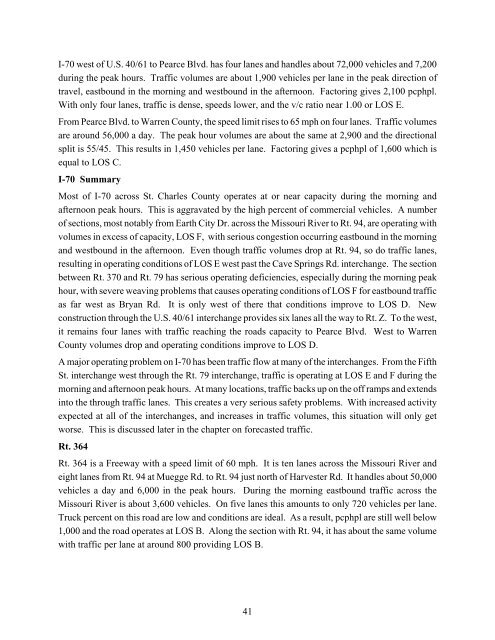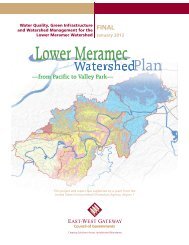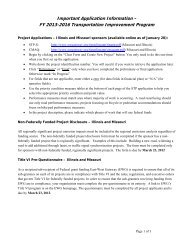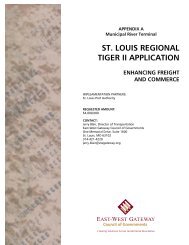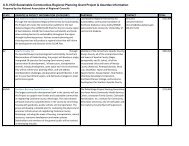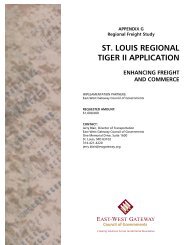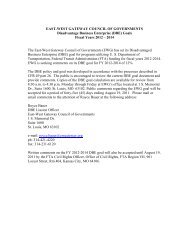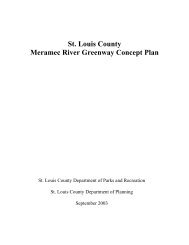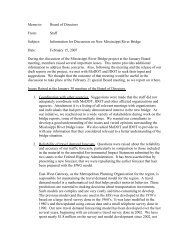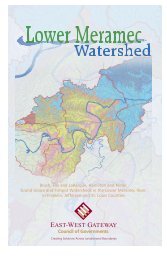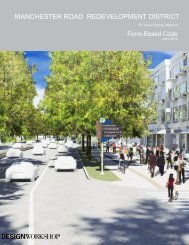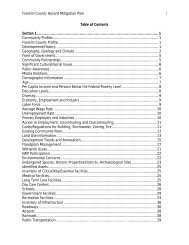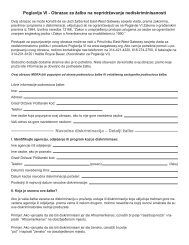St. Charles County Transportation Plan 2030 - East-West Gateway ...
St. Charles County Transportation Plan 2030 - East-West Gateway ...
St. Charles County Transportation Plan 2030 - East-West Gateway ...
You also want an ePaper? Increase the reach of your titles
YUMPU automatically turns print PDFs into web optimized ePapers that Google loves.
I-70 west of U.S. 40/61 to Pearce Blvd. has four lanes and handles about 72,000 vehicles and 7,200<br />
during the peak hours. Traffic volumes are about 1,900 vehicles per lane in the peak direction of<br />
travel, eastbound in the morning and westbound in the afternoon. Factoring gives 2,100 pcphpl.<br />
With only four lanes, traffic is dense, speeds lower, and the v/c ratio near 1.00 or LOS E.<br />
From Pearce Blvd. to Warren <strong>County</strong>, the speed limit rises to 65 mph on four lanes. Traffic volumes<br />
are around 56,000 a day. The peak hour volumes are about the same at 2,900 and the directional<br />
split is 55/45. This results in 1,450 vehicles per lane. Factoring gives a pcphpl of 1,600 which is<br />
equal to LOS C.<br />
I-70 Summary<br />
Most of I-70 across <strong>St</strong>. <strong>Charles</strong> <strong>County</strong> operates at or near capacity during the morning and<br />
afternoon peak hours. This is aggravated by the high percent of commercial vehicles. A number<br />
of sections, most notably from Earth City Dr. across the Missouri River to Rt. 94, are operating with<br />
volumes in excess of capacity, LOS F, with serious congestion occurring eastbound in the morning<br />
and westbound in the afternoon. Even though traffic volumes drop at Rt. 94, so do traffic lanes,<br />
resulting in operating conditions of LOS E west past the Cave Springs Rd. interchange. The section<br />
between Rt. 370 and Rt. 79 has serious operating deficiencies, especially during the morning peak<br />
hour, with severe weaving problems that causes operating conditions of LOS F for eastbound traffic<br />
as far west as Bryan Rd. It is only west of there that conditions improve to LOS D. New<br />
construction through the U.S. 40/61 interchange provides six lanes all the way to Rt. Z. To the west,<br />
it remains four lanes with traffic reaching the roads capacity to Pearce Blvd. <strong>West</strong> to Warren<br />
<strong>County</strong> volumes drop and operating conditions improve to LOS D.<br />
A major operating problem on I-70 has been traffic flow at many of the interchanges. From the Fifth<br />
<strong>St</strong>. interchange west through the Rt. 79 interchange, traffic is operating at LOS E and F during the<br />
morning and afternoon peak hours. At many locations, traffic backs up on the off ramps and extends<br />
into the through traffic lanes. This creates a very serious safety problems. With increased activity<br />
expected at all of the interchanges, and increases in traffic volumes, this situation will only get<br />
worse. This is discussed later in the chapter on forecasted traffic.<br />
Rt. 364<br />
Rt. 364 is a Freeway with a speed limit of 60 mph. It is ten lanes across the Missouri River and<br />
eight lanes from Rt. 94 at Muegge Rd. to Rt. 94 just north of Harvester Rd. It handles about 50,000<br />
vehicles a day and 6,000 in the peak hours. During the morning eastbound traffic across the<br />
Missouri River is about 3,600 vehicles. On five lanes this amounts to only 720 vehicles per lane.<br />
Truck percent on this road are low and conditions are ideal. As a result, pcphpl are still well below<br />
1,000 and the road operates at LOS B. Along the section with Rt. 94, it has about the same volume<br />
with traffic per lane at around 800 providing LOS B.<br />
41


